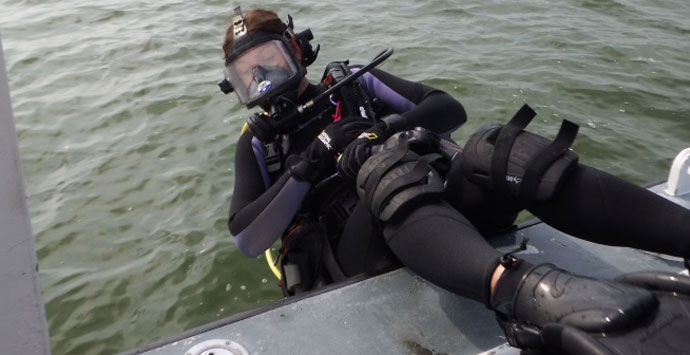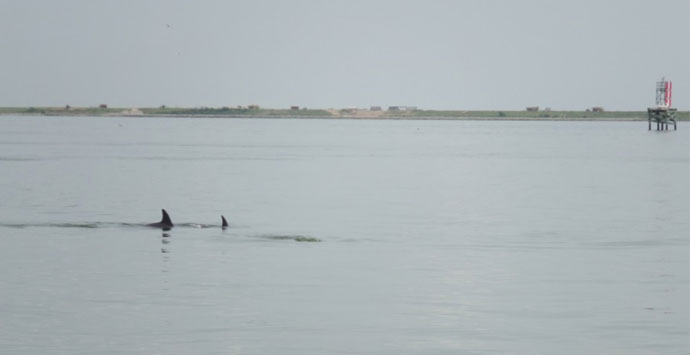#CoolJobs: AECOM underwater!
I spend most of my everyday work life above water. However, on occasion, I get the opportunity to explore the underwater world — and I get paid for it!
I’ve been an active member of the AECOM Self-Contained Underwater Breathing Apparatus (SCUBA) dive team for five years, conducting projects in New England, United States, and the Gulf of Mexico. Prior to diving for AECOM, I was a member of another scientific dive team in Washington state. I’ve been a certified SCUBA diver for 15 years — achieving my open water certification at 16 years old when I discovered my love for the marine environment during a high school marine science class. Since my certification in 2001, I’ve conducted many recreational dives (for fun) and scientific dives (for work) and have enjoyed every underwater adventure.
Most recently, AECOM’s dive team conducted an oyster population density survey in the Gulf of Mexico within a proposed shipping channel in Galveston Bay. The population counts that AECOM’s dive team generated helped to dictate mitigation efforts that are used to minimize impacts on the ecosystem during channel dredging, which is the removal of sediments and debris from the bottom of lakes, rivers, harbors, and other water bodies. In order to estimate oyster populations, the dive team used a 0.25-square-meter quadrant (square) and laid it down on the sediment at numerous locations along a transect line (measuring tape). The number of oysters within each square was recorded and from that, a larger population was estimated.
 Kaitlin splashes into Galvenston Bay in Texas to begin oyster survey work.
Kaitlin splashes into Galvenston Bay in Texas to begin oyster survey work.
The team’s Galveston Bay trip turned into quite the adventure! And let me say, Texas in July is HOT. Initially, I thought jumping into the water to conduct the survey work would be a nice reprieve from the heat. But with average water temperatures in July hovering close to 90 degrees Fahrenheit, it was more like jumping into a hot puddle.
Each morning, and often in the afternoon, our boat was greeted by a pod of dolphins curious about what we were up to in their turf. To be honest, the sight of a fin in the water was pretty unnerving at first and, at some points during my dives, I was convinced a dolphin swam right next to me, although I couldn’t see it (more on that later).
 AECOM’s dive team spots a pod of Bottlenose dolphins in Galveston Bay, Texas.
AECOM’s dive team spots a pod of Bottlenose dolphins in Galveston Bay, Texas.
We were able to achieve a seemingly impossible goal of conducting an oyster survey in water where the visibility was close to zero (meaning you could barely see your hand or a dolphin directly in front of your face). I jokingly refer to the dives we did in Galveston Bay as “blind dives,” and even though I was diving with a partner who I knew was only a couple of feet away, it felt like I was alone because I was unable to see him. However, to ensure we were always together underwater, we used our survey quadrant, as a tether. Diving in teams of two, each diver held on to a side of the square as we swam along the transect survey line. Surface support divers constantly watched our bubbles to ensure we were together and heading in the right direction as navigating with a compass was difficult in such low visibility.
 Kaitlin holds onto the survey quadrant prior to heading underwater in Galveston Bay, Texas.
Kaitlin holds onto the survey quadrant prior to heading underwater in Galveston Bay, Texas.
While diving for AECOM, part of our standard gear is a full facemask with a built-in speaker and microphone. This facemask enables us to speak to each other underwater and also allows us to communicate with the topside support. Without this piece of equipment, our “blind dives” would have been impossible.
The dives we did in Galveston Bay were extremely unique and challenging in nature, but allowed us to work as a team — providing support to one another under less-than-favorable conditions. Being a part of the dive team allows me to go places that I never thought were possible and to build relationships with people in many regions and practices within our company. The ability for us to provide the service of scientific scuba skills to our clients is incredibly unique. The dive team and I are always looking for a new adventure and enjoy being innovative to achieve project goals.
I’ll be above water for now — but will be sure to write in about our next AECOM underwater adventure!
If you have any questions or comments about my diving experiences, please leave me a note below!
 Kaitlin Sylvester is a marine and freshwater scientist in AECOM’s environment business and has been scuba diving since 2001.
Kaitlin Sylvester is a marine and freshwater scientist in AECOM’s environment business and has been scuba diving since 2001.
LinkedIn: Kaitlin Sylvester






